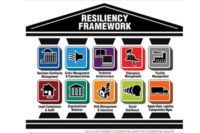What will you do when disaster strikes? How will you provide safety and security to your employees and facilities in the event of a natural or man-made catastrophe? What critical systems do you need to shut down during a cyberattack?
Early minutes or seconds can make a difference between survival or disaster. When this happens, the value of “situational intelligence” is critical. It is a foundation in any effective risk and resiliency management strategy.
The report entitled “Recommendations for Crisis Management” (published by UIC, along with COLPOFER and UITP, 2017) put it this way: “During an escalating situation or a developing crisis, the timely information of the internal organization, the authorities, and the public is essential.” It adds:
- “The more serious the situation, the larger the circle of those requiring information and
- For the initial internal information, speed is more essential than precision”
Internal responders need to be trained and prepared to make decisions in a crisis, and the need for speed is essential. The proper situational intelligence solution can deliver targeted information significantly faster than traditional information sources (such as the news media). With the right technology, situational intelligence alerts can be designed with interfaces that will grab your attention and alert you automatically, saving resources that are necessary to monitor other issues.
It often happens that the most useful information to your organization is what you would never expect from traditional sources. For instance, media outlets may tell you of a fire “downtown.” But what if the fire is on or near your property? What if it’s the middle of a weekend night and no one is on premises to report it that your facility is in danger?
The right situational intelligence is vital to minimizing risk and keeping you operational. In the previous situation, you would have been alerted by your internal risk management system. You will have been enabled to respond even faster and more accurately. Your initial response will be much less prone to human error from relying on traditional sources of information.
When a disaster strikes, time could be lost as responders get acclimated, deploy their equipment and review the situation. So how can you can mitigate the potential for human delay or error and avoid mistakes or missed observations?
The answer is to incorporate your situational intelligence through an automated feed directly into your risk and resiliency management system. Your preparation should enable an immediate disaster response that gives your emergency responders the head start they need.
A best practice in risk and resiliency management is planning initial disaster responses based on rules that you have been able to think through in normal times. You can pre-plan, knowing that you have access to your full information foundation that contains data that defines the potential impact such as sites, facilities, vendors, the location of your people and teams, where your products are manufactured and distributed and the complete set of plans you’ve developed.
No one should wait for a crisis and/or react solely on instinct – especially when you have the information and tools to configure your risk management system to take your knowledge (including previous related incidents) and build the initial response and activation plan. Then, when your first responders are notified, they can enter the command and control center with a predefined scenario ready to be acted upon.
It’s likely that first responders will need to make situational adjustments, but the room for error in missing a critical site or vendor or plan to include in the response is greatly decreased. The situational intelligence feed provides the critical and timely trigger, and the knowledge contained in the risk management system with the workflows that have been preconfigured have created a complete scenario ready to be activated in far less time and with far greater accuracy.
Even the best situational intelligence alert may contain information that may take extra time for your staff to evaluate and act upon, i.e.: Where is the event occurring exactly? How close is it to any of my locations, partners or people? What type of event is it? How severe is it? What else is going on in that area right now? But by filtering for what is most important, you can focus on critical situations that you have predetermined create significant risks.
Your incident command center will benefit from your situational intelligence, giving you more meaningful after-action reports that include your actions taken as well as alert history. This will provide a more fulsome picture when you refine your future risk and resiliency plans.
The historical event information accumulated through an integrated situational intelligence feed and risk and resiliency system should be a key input to your overall decision support system. If, for example, you want to assess the risk of relocating part of your business in a new area, you will have data in one place that can be used for much more informed decisions.
Remember when planning your next crisis management exercise to ask if you are enabling your situational intelligence by feeding it directly into your risk and resiliency system to drive faster, more accurate responses. Every minute or second truly does count.







